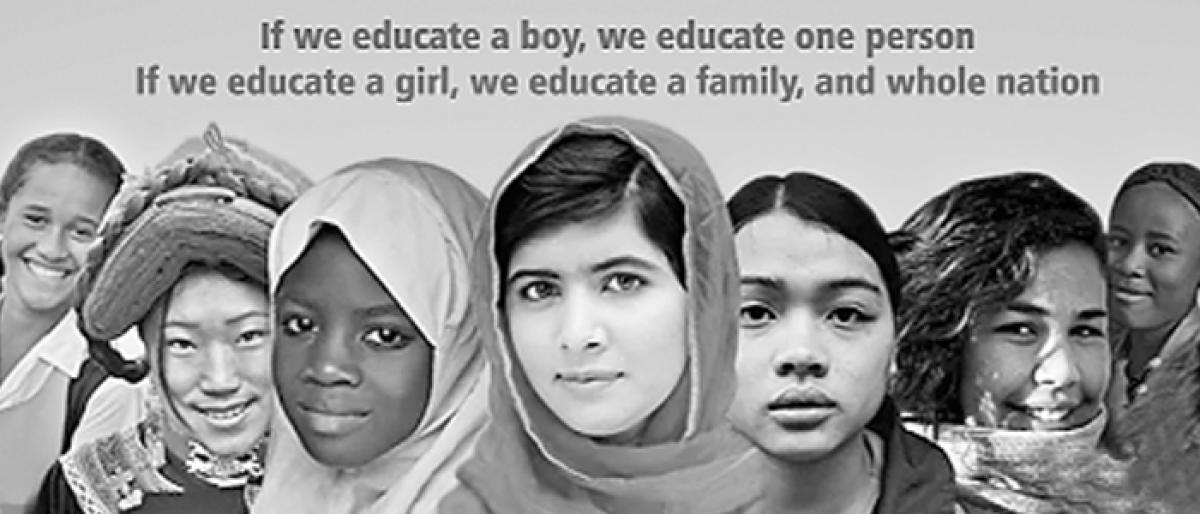Live
- Three persons admitted to hospital for diarrhea treatment
- First Star Outside Milky Way Captured: WOH G64 is 2,000 Times Larger Than the Sun
- Sikkim govt to constitute state Niti Ayog: CM Tamang
- CBI books Rajasthan narcotics inspector for Rs 3 lakh bribe
- Rajasthan bypolls: A tough contest between BJP and Congress
- Albania joins SEPA, paving way for EU integration
- Japanese government approves 250-billion USD economic package to ease price pain
- Six pharma companies to set up their units in Telangana
- The Unstable Events of a 17-Wicket Day in Perth: India vs Australia
- Dutch FM's Israel trip cancelled after Netanyahu's arrest warrant
Just In

Globally, nine in ten girls complete their primary education, but only three in four complete their lower secondary education In low income countries, despite progress over the last two decades, less than twothirds of girls complete their primary education today, and only one in three completes lower secondary school
Globally, nine in ten girls complete their primary education, but only three in four complete their lower secondary education. In low income countries, despite progress over the last two decades, less than two-thirds of girls complete their primary education today, and only one in three completes lower secondary school.
As per World Development Report 2018, girls just like boys suffer the consequences of a global learning crisis, by which too many children in the developing world do not acquire the foundational skills that a functional education system ought to ensure.
Girls tend to outperform boys in reading, but they score lower in Mathematics and Science tests in many countries. While there is no systematic data on socio-emotional skills across countries, education systems that fail to deliver these basic skills are also likely to underperform in nurturing important socio-emotional skills.
Education matters for all children, but especially for girls in some areas. When a child does not finish secondary school, or does not learn what is needed to function productively as an adult, potential costs are high for boys and girls alike in terms of lost earnings.
But not educating girls is especially costly in part because of the relationships between educational attainment, child marriage, and early childbearing, and the risks that they entail for young mothers and their children. In addition, occupational segregation by gender between paid and unpaid (housework and care) work, and between types of employment and sectors, also lead to especially high potential costs for girls.
While primary schooling is necessary, it is not sufficient; progression of girls to higher educational attainment is an imperative. But the implication is that while primary schooling lays the foundation for future learning, it is essential to enable girls to pursue their education through the secondary level and to ensure that learning occurs in order to reap the benefits from more education.
Women with primary education (partial or completed) earn only 14%-19% more than those with no education at all. By contrast, women with secondary education may expect to make almost twice as much, and women with tertiary education almost three times as much as those with no education.
Secondary and tertiary education are also associated with higher labor force participation, and especially full-time work. Finally, women with secondary and tertiary education report higher standards of living compared to those with primary education or lower.
Each additional year of secondary education is associated with lower risks of marrying as a child and having a child before age 18 by six percentage points on average. If universal secondary education is achieved, child marriage could be virtually eliminated, and the prevalence of early childbearing could be reduced by up to three fourths since early childbearing goes hand in hand with child marriage.
Universal secondary education could reduce total fertility. About two-thirds of this potential impact could come from education itself, and one-third from ending child marriage. This could generate a large demographic dividend.
Universal secondary education could also lead to an increase in modern contraceptive use of a fourth from the base. Population growth could be reduced substantially, especially in countries that have not yet achieved the demographic transition. Universal secondary education will also increase women’s knowledge of HIV/ AIDS and their ability to make decisions about their own healthcare by one-fifth nationally. Women’s psychological well-being could also improve and the risk of intimate partner violence could decrease.
Achieving universal secondary education could increase by one tenth women’s reported ability to make decisions within the household, from baseline values. Women with secondary education report lower satisfaction rates with basic services than women with no education, which may reflect a more realistic assessment of their quality.
Finally, having a secondary education is associated with higher birth registration in some countries, although results are not robust across countries. As with the other indicators, while some benefits could result from universal primary education, they would be smaller.
Achieving universal secondary education could enable more women to display altruistic behaviors such as volunteering, donating to charity, and helping strangers, with a change of up to one tenth from baseline values.
Thus, more needs to be done to improve educational opportunities for girls, as well as learning while in school. Countries need to make necessary investments in the inputs required to improve both access and learning, and adopt policy reforms that can propel the economy to grow and generate jobs for a more educated workforce.
By:Pradeep Kumar Panda

© 2024 Hyderabad Media House Limited/The Hans India. All rights reserved. Powered by hocalwire.com







